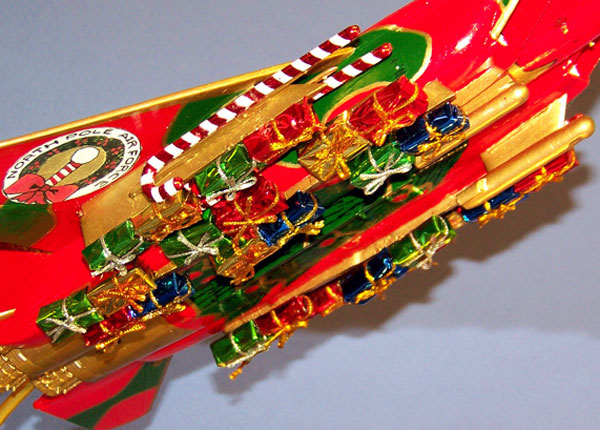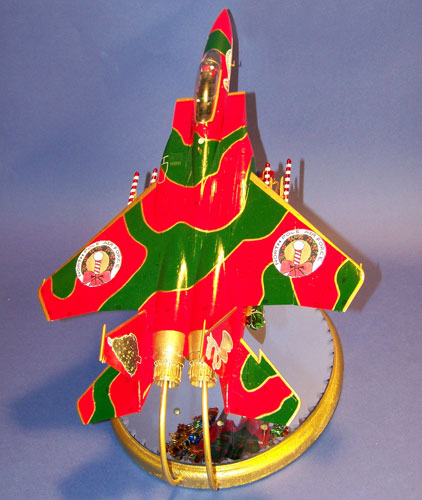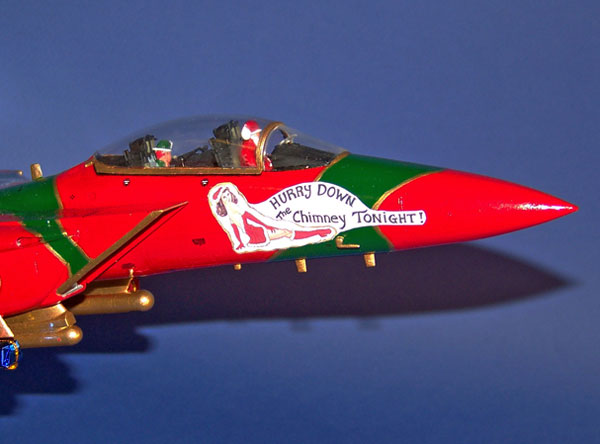|
Santa's 1/48 scale
F-15NP Eagle TDS
by
Mike Snider
(Canadian, and formerly a child)
|
 |
|
Santa’s F-15NP Eagle TDS |

HyperScale is proudly supported by
Squadron
Nearly a decade ago, it was becoming increasingly obvious to Santa
that the old sleigh and eight* tiny reindeer simply were not up to the
task of delivering in one night Christmas presents to the billions of
good little children around the world.
Santa required a state-of-the-art Toy Delivery System (TDS) to replace
his ageing RPS (Reindeer Pulled Sleigh). This had been state-of-the-art
when first deployed but had fallen behind due to unavailability of parts
and recurring breakouts of hoof and mouth disease.
Originally the elves in the flight design department worked on an
upgrade to the RPS. This evolved into a completely new air vehicle
incorporating the latest stealth design features and thrust vectoring.
However, cost overruns and political infighting among the designers and
bureaucrats led Santa to follow another path. Since he did not have to
appoint a large committee to solve his problem, he just went to the
aircraft manufacturers with his specs.
In spite of the manufacturer’s lawyers’ best efforts to sink the deal,
Santa was eventually able to prevail on the more sensible heads at the
company and a deal was struck. Even so, the manufacturer demanded--and
Santa finally acquiesced--to retain full copyright on the aircraft
designation. At least good ol’ Santa walked away with a fully
mission-capable toy delivery system.
Santa’s New Toy Delivery System (TDS)
The final air vehicle chosen for modification was the F-15E Strike
Eagle. Santa required a number of major changes to both the airframe and
electronics.
-
The M61 Vulcan cannon was highly
modified to fire subsonic jellybean (JB) projectiles. The JBs
themselves underwent thousands of hours of testing in both wind
tunnels and anonymous family homes until the proper velocity,
ballistic trajectory, and flavors had been identified. Well-known
munitions expert (and modeler) Jim Rotramel was instrumental in this
design and testing process. There were several serious arguments on
the appropriateness of including licorice as one of the flavors.
Several elves were of the opinion that licorice was more
appropriately used as a horse tranquillizer than a child’s candy.
-
The manufacturer found it was
considerably less trouble than expected to modify the LAU-128
missile launchers to accept large candy canes instead of Sidewinders
and AMRAAMs. The canes themselves caused a certain amount of buffet
during stores separation, but in spite of considerable wind tunnel
testing that suggested a series of more aerodynamic shapes, Santa
put his foot down and demanded the original configuration be
retained. He stated “A rough ride is well worth it if the kids get
what they want.”
-
The ejection seats are primarily an
“off the shelf” system, but the rear cockpit seat has been modified
as noted below.
-
It was also less work than expected
to modify the wing hardpoints to accept the blunt-ended, rectangular
cross-section presents. The lead flight test engineer was so
impressed that he was heard to remark, “I have advanced degrees.
I’ve worked on major defense technological programs. What the hell
am I doing here?”
-
This advanced TDS also required a
completely new concept in toy packaging. Although externally
identical to earlier packaging, the embedded electronics of this new
generation of SPs (Smart Presents), coupled with the SGNPDS and
SGRTAS (see below) have created a true exponential leap in Santa’s
delivery efficiency.

-
Additional squabbling occurred when
the Lead Elf demanded the Santa’s Global Navigation Presents
Delivery System (SGNPDS) & Santa’s Gift Recipient Target Acquisition
System (SGRTAS) pods be coated in real gold. This incident was
brought to a peaceful conclusion when Santa agreed to foot the extra
charges, saying, “With all the cheap stuff we’re getting from China,
we can afford to splurge once in a while.”
-
Most impressively, the combination of
the SPs, SGNPDS, and SGRTAS has created the world’s first “deliver
and forget” targeting system.
Some have asked what qualifies Santa to fly such an advanced
aerospace system. Others have even questioned where Santa went to flight
school, but this is obviously a misdirected question as he is the proud
holder of the ORIGINAL pilot’s license number 1.
News reports have identified Santa’s elf backseater as “Herbie the Wizzo,”
who, because he didn’t like to make toys, instead spent a year at Mather
AFB studying navigation, and then a tour with the 48th TFW in F-111s.
His combat tour was sadly cut short when Herbie had a run-in with the
wing commander, who apparently was the first person to notice Herbie’s
head did not rise above the level of the canopy rails unless he sat on a
large stack of phone books. There had previously been some grumbling
from the wing safety officer about the likelihood of the phone books
causing problems during an ejection, but no one ever followed through on
that issue. The “new generation” TDS has solved that problem with a
simple modification to the rear ejection seat cushion. This mod has
worked so well the USAF is actively considering it for WSO seats in all
combat aircraft.
Background on the Camouflage & Markings
The manufacturer was nearly useless in the development of TDS
markings. However, the artists assigned to the huge North Pole Air Force
(NPAF) underground control center (modeled on the Strategic Air Command
Underground Command Post) designed a scheme that is extremely effective
at night, yet pleasing to the eye.
The scheme is loosely based on an “aggressor” pattern Santa observed
while visiting Las Vegas a few years ago. He unobtrusively joined a
public tour at Nellis AFB, and although several small children clearly
identified him, disaster was averted when older siblings scolded them
that “there is NO Santa!”
Although not originally a part of the camouflage scheme, a lowly and
dim-witted elf researcher named Scotty identified an earlier camouflage
concept by artist Keith Ferris that uses a “false canopy” painted on the
bottom of an aircraft. The elf artists adapted this concept to add the
image of a fully decorated Christmas tree to the bottom of Santa’s jet.
The royalty arrangement with Mr Ferris is being worked out now.

The standard North Pole Air Force (NPAF) roundel applied above and below
each wing is a Christmas wreath with the North Pole in the center.
The unit badge of the 1st ATDS (Aerial Toy Delivery Squadron), nicknamed
the “Flying Reindeers,” decorates the outsides of each vertical tail.
The 4th NPEF (North Pole Elves Flight) won the coin toss to have their
unit insignia, a beautifully decorated Christmas tree, emblazoned on the
inner face of each vertical fin.
Nose Art
Many think that aircraft “girlie” nose art is purely an artifact of
World War II, and to a much lesser degree, modern military aircraft. Not
so.
While a very longstanding disinformation campaign by the NPIS (North
Pole Intelligence Service, an organization charged with determining
“who’s naughty and who’s nice” as well as protecting Santa’s North Pole
refuge) has convinced us that Mrs. Claus is a rotund, jolly lady much in
Santa’s physical mold, in fact Ms. Claus is a true “hottie” by anyone’s
standards.
Santa may be the servant of the world’s children for one night a year,
but after all there are 364 other nights in the year. Santa ain’t no
fool!

In an intelligence coup unequalled in history, the CIA was able to
obtain several surreptitious photos of the nose art on the F-15NP before
it left the factory. These photos, which we were able to borrow but not
reproduce here, show conclusively that the right side nose art is an
anatomically correct illustration of Mrs. Claus inviting Santa to “hurry
down the chimney tonight” (in honor of the song sung by Eartha Kitt).
This artwork is revealed here for the first time anywhere.
Santa has honored the many decades of service rendered by his faithful
reindeer (all of which are stags), and the left side of the nose sports
artwork that appears to commemorate the long service of his reindeer and
old-fashioned sleigh.
However, upon closer inspection, it is possible to identify all the
reindeer in this sled team as does with antlers tied to their heads.
We’re told by reputable sources that all of them are also, in fact, “hotties.”
Thus, though “girlie” nose art has been with us for some time, this is
the first known example of “doe-ie” nose art.
I am quite honored to have been asked to produce this exact scale model
of the TDS. I based it on the 1/48 Revell F-15E, which provided the most
accurate starting point and required the least modification.
In reality, this project originated when my wife asked, “what type of
plane would Santa fly?” I quickly replied, “an F-15 Strike Eagle.” The
project grew by leaps and bounds, and resulted in what you see here. The
artwork was hand drawn and reproduced on a color copier.
I hope you enjoyed this as much as I did!
Merry Christmas!
Mike Snider
NO ANIMALS WERE INJURED OR KILLED DURING THE PRODUCTION OF THIS MODEL.
Footnote
*Note that Rudolph is not included in this number. This is a sad
story in itself. Rudolph was a huge success when he was first added to
the flight team. However, over the years it became more and more
difficult to obtain replacement nose lights.
In fact, the original manufacturer of those lights eventually went out
of business due to the massive downsizing of the defense aerospace
industry, and no other manufacturer was willing to produce the design in
the small quantities needed by the NPAF. For a dismal, but thankfully
short, time a Chinese manufacturer made the replacement light, but the
lead content was so high that Rudolph began to suffer noticeable health
issues.
Click the thumbnails below to view larger
images:
[../../photogallery/photo00007239/real.htm]
Model, Images and Text Copyright © 2007
by Mike Snider
Page Created 24 December, 2007
Last Updated
24 December, 2007
Back to
HyperScale Main Page
|
Home
| What's New |
Features |
Gallery |
Reviews |
Reference |
Forum |